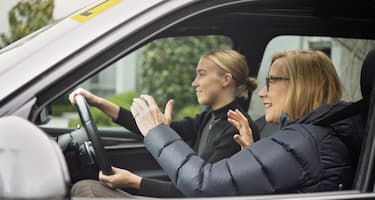Key Findings
Melbourne, Victoria ranked the best city for young drivers (under 25s)
Canberra ranked as the worst city for young drivers
Brisbane has the lowest crash fatalities per 100,000 population
Cairns had the highest number of road fatalities in 2022
Townsville is the city with the highest number of households with registered vehicles
One of the most exciting rites of passage in any young person’s life is getting their driver's licence. Being legally able to drive can mean so much more than getting from A to B. For many, those car keys symbolise freedom!
So once you’ve got your licence, your roadworthy and insured vehicle, and your car keys, it’s as simple as jumping in your car and hitting the open road, right?
Well, yes and no. Many people say the “real learning to drive” starts after you pass your test and you’re without the support of a qualified instructor. It can be quite daunting going out on those first few trips alone, and more so daunting if you’re heading further afield. Things like congested and dangerous roads, as well as the cost of running a car are all common concerns of youngsters.
So what's it like to drive in Australia under 25? Budget Direct commissioned Research House, Aira, to analyse and rank a series of key metrics concerning young drivers such as cost factors, like the price of petrol, the average cost of insurance and to register your vehicle as well as the price of parking. These were measured alongside safety worries like the number of road fatalities and how many vehicles are registered at households in the top 20 most populated cities and regions across Australia.
Find out where your city scores below.
Which city is the best overall for young drivers in Australia?
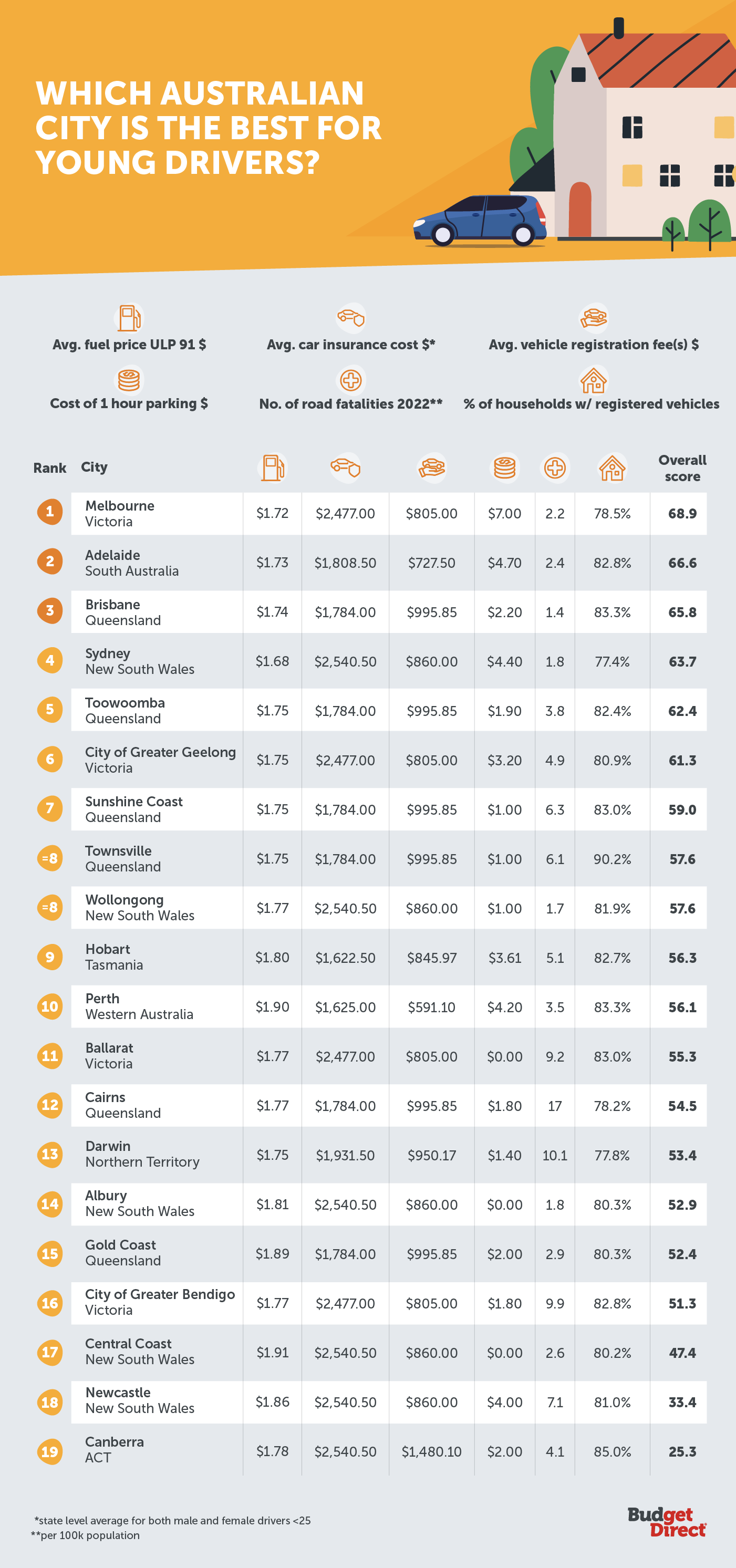
According to the index data, scoring 68.9 points out of a possible 100, Melbourne, Victoria, is in pole position for the best city to drive in for young drivers. With regards to cost metrics, Melbourne was recorded as having some of the lowest priced ULP 91 fuel per litre at $1.72, Melbourne also had some of the lowest crash fatality figures per 100,000 population.
In terms of car insurance for young drivers and the cost of registering a vehicle, Melbourne sits in the upper cost bracket versus other cities. With average cost of car insurance coming in at $2,477.00 and average vehicle registration fees costing $805.00, it’s an expensive city for young drivers to get onto the roads.
Ranking as the worst city for young drivers is Canberra. Scoring just 25.3 in our index, the capital city has high insurance costs ($2,540.50), high registration fees ($1,480.10) and is home to busy suburbs with 85% of households owning vehicles.
The capital city however, does benefit from cheaper parking at $2.00 for 1 hour. You’ll also find reasonable fuel costs compared to other cities at $1.78 per litre.
How many fatalities were reported in each city in 2022?
According to the Australian BITRE website , in the last 12 months (including the current month), there was a 4.6 annual road fatality rate per 100,000 population. This is an increase of 6.0% compared to the 12-month period ending in January 2022. In actual numbers, there were 1,208 deaths recorded, an increase of 82 deaths compared to the 12 months ending January 2022.
The data trend shows that the annual total of road-related deaths is +111.6% above the National Road Safety Strategy 2021-2030 target, which is a worrying statistic.
With road deaths increasing across Australia, we looked specifically at city and regional level deaths to find out where the least number of fatalities were recorded in 2022. To determine these figures, we downloaded official statistics from BITRE’s fatal road crash database , and took the sum of fatalities, from the LGA city and regional data for 2022, converting them to per 100,000 population for more accurate results.
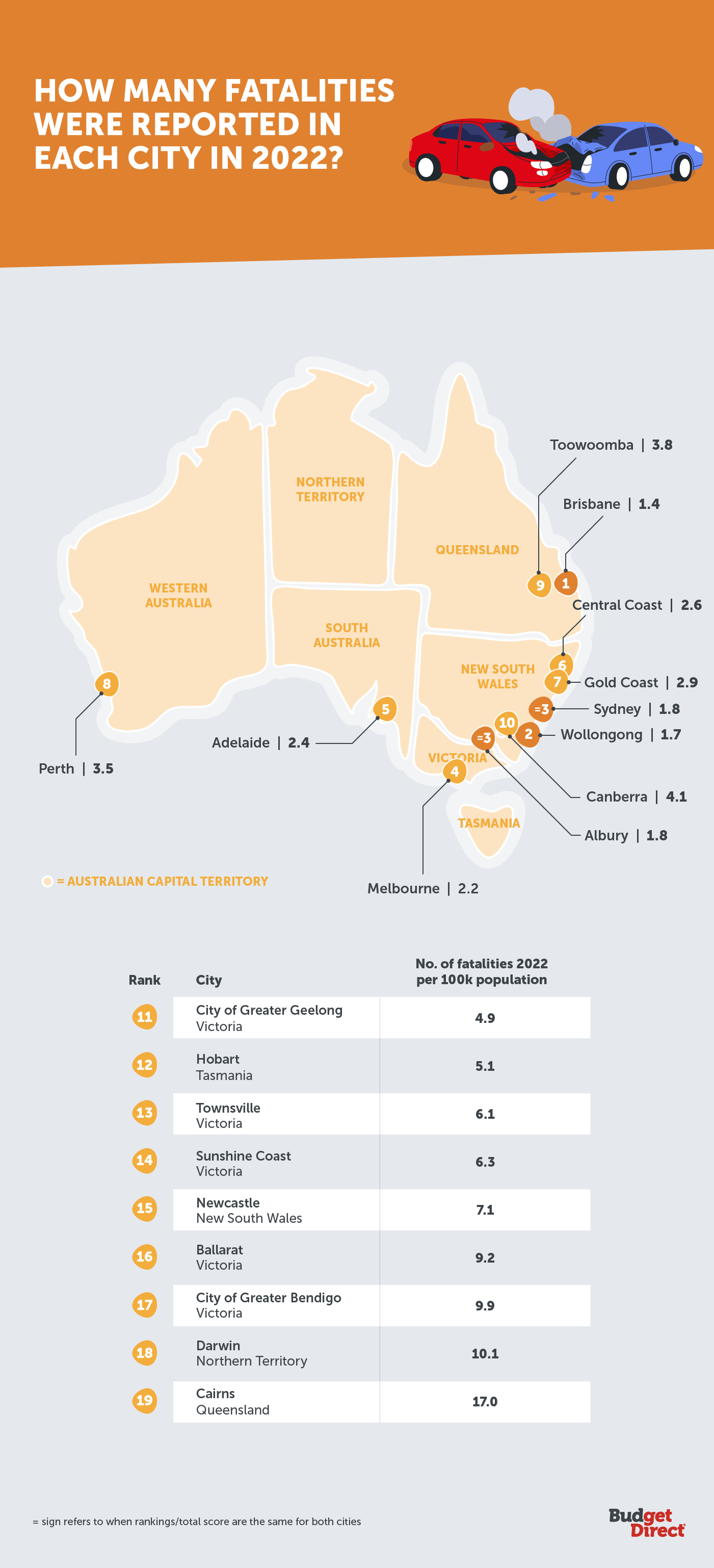
According to the data, Brisbane, in Queensland, recorded 1.4 road fatalities per 100,000 population in 2022.
Wollongong, Sydney and Albury all recorded less than 2 deaths per 100,000 population. In Cairns, there were 17 road deaths per 100,000 population recorded - the most of any city.
Darwin and the City of Greater Bendigo follow Cairns as the cities with the highest recorded fatalities per 100,000 population with 10.1 and 9.9 respectively.
Which city has the lowest number of registered vehicles per household?
Whilst Cairns had the highest number of road fatalities recorded of the cities analysed, it actually has the third lowest percentage of households with registered vehicles, at 78.2%. This may suggest that there is less traffic on the road in Cairns, however the fluctuating weather conditions could also play a part in the statistics.
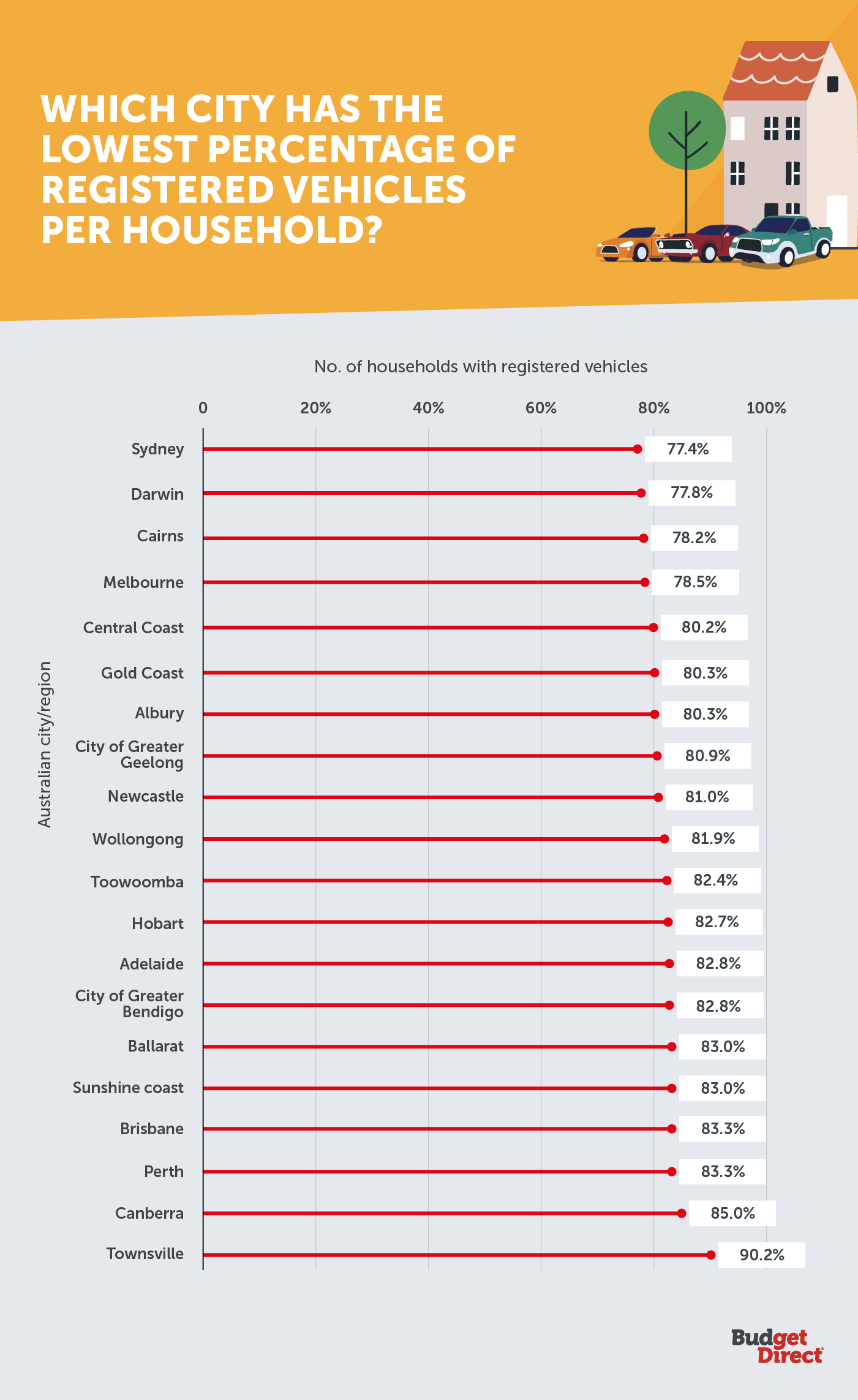
The city which has the lowest percentage of households with registered vehicles is Sydney, New South Wales (77.4%) Darwin follows in second place with 77.8% of dwellings having registered vehicles. Cairns completes the top three with 78.2%.
The average cost of vehicle registrations in each Australian state
The cost for registering a vehicle in Australia varies from state to state, and can range from a few hundred dollars to over a thousand. Car registration costs are calculated in a multitude of different ways and are governed at state and territory level. The factors involved range from vehicle weight, to the number of cylinders, to the engine size in cubic centimetres.
Some states include Compulsory Third Party Insurance (CTP) within the registration fees, whereas in others it has to be purchased separately in order for you to be legally able to drive your vehicle.
We analysed all of the various costs to register your vehicle in Australia from each state’s government website and determined that the Australian Capital Territory (ACT) is the most expensive, on average at $1480.10.
ACT vehicle registration is made up of three components, which are government fees, registration fees and MAI (Motor Accident Injuries) insurance premiums. MAI Insurance premiums for tare weights, government fees and registration fee components have been added together. An average has then been taken across all total registration fees for tare weights.
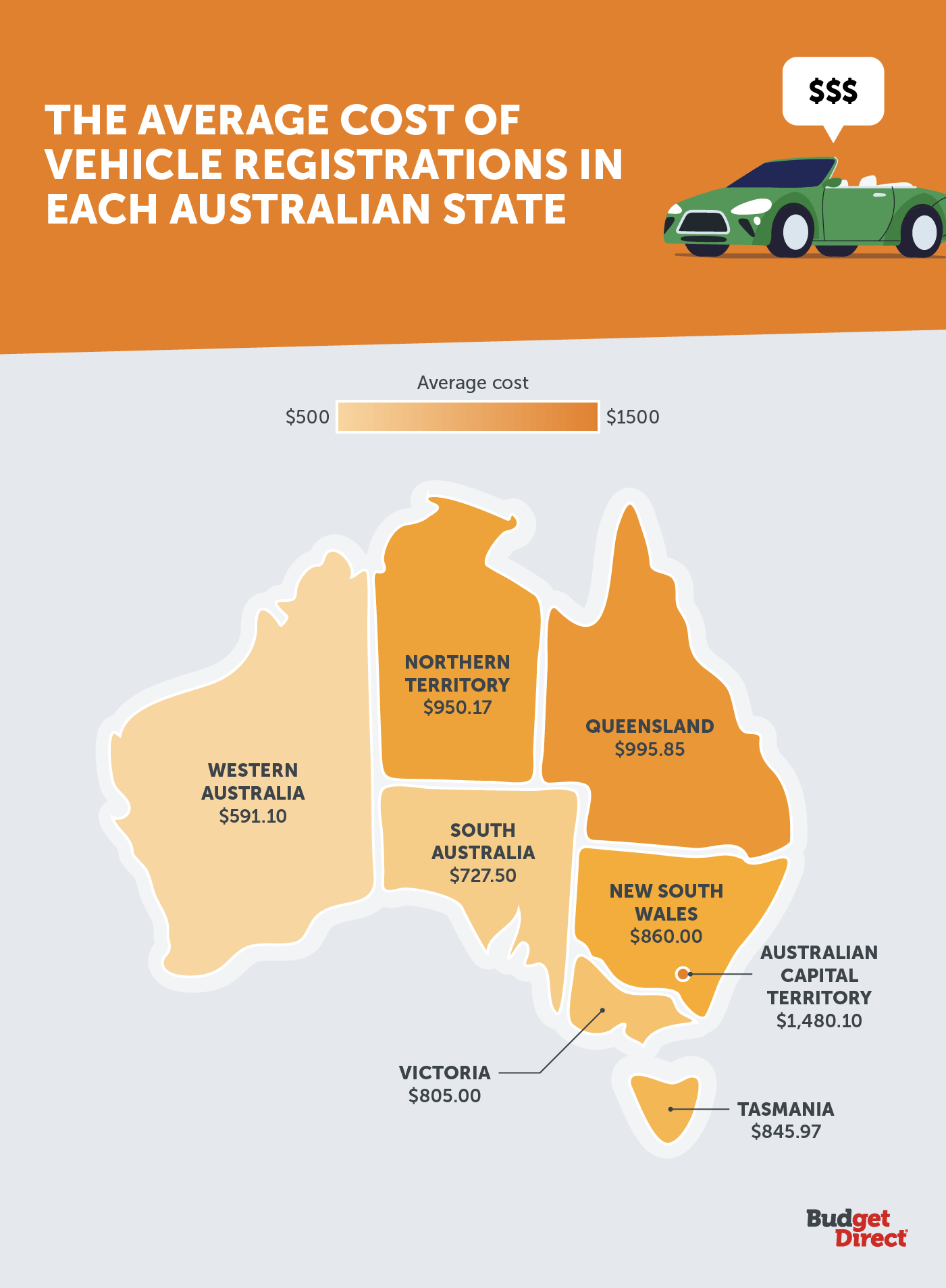
By comparison, the least expensive state to register a vehicle is Western Australia at $591.10. In this state, charging registration is based on the weight of a vehicle. Passenger cars, SUVs, and light commercial vehicles pay registration at a rate of $25.52 per 100 kg. Western Australia’s Department of Transport calculates your registration fee based on the weight of the vehicle, something they call “kerb mass”. We took an average of the “kerb mass” rate across common car weights. Also included in these fees is their CTP insurance equivalent, called Motor Injury Insurance. There is also an admin fee of $10.30.
Even though Western Australia’s vehicle registration fees are made up of similar components to ACT, it is still around $889 less than the capital’s car registration fees, meaning that younger drivers outside of Canberra can get a much better deal in the earlier years of having their licence.
Tips for learner drivers
If you or your child is learning to drive, thinking about all of the essential costs and additional things that come with driving such as safety and appropriate insurance cover are good places to start to ensure you get the best deals and know what to expect.
In order to get the correct car insurance for P-platers, there are a few considerations to be made., You would want to decide whether to insure them on your own car insurance policy, or whether your child will purchase their own car to learn in. If you add them to your own policy, your premium may increase. That’s because statistically, younger drivers are more likely to have an accident.
If another car is bought for them to learn in and they’ll be driving it more often than anyone else, you’d need to get a quote and buy a new car insurance policy, listing the child as the regular driver.
Next, you’ll need to consider car insurance excess, with the basic excess varying from state to state and territories. This excess is payable regardless of a driver’s age, licence type or driving experience. Any other additional excess is the fixed amount you pay towards a claim for loss or damage to your car and can vary for depending on the age of the driver, and for drivers that have not held a full Australian open licence for two or more years.
Methodology
1. Fuel price - collected manually from https://fuelprice.io/ for each city using ULP price per litre in AUS $
2. Number of accidents/fatalities have been taken from the Australian Road Deaths Database, fatal crashes data, using LGA data for each city/region. Data is correct as of December 2022
3. Avg. cost of insurance has been taken from www.canstar.com.au. Prepared on 09/08/2022. Based on comprehensive car insurance policies rated in Canstar’s 2022 Car Insurance Star Ratings Premiums. This includes quotes for both new and used cars focusing specifically on premiums for male and female drivers aged 25 and below with a state-specific target excess ranging from $600 to $750. NSW and ACT premiums have been combined into NSW premiums. An average of males and females aged 25 and below has been taken and applied at the state level. Individual city-level data is unavailable so state-level data has been applied to cities and regions.
4. Number of registered cars data has been taken from https://profile.id.com.au/ using the number of households with 1 or more registered vehicles in each city/region. We’ve used this metric instead of the number of registered vehicles as this data isn’t available for Vic, SA and NT.
5. Average vehicle registration fees have been taken directly from each state's government website as these vary from state to territory. City/regional data is unavailable so state data has been used. The specifics have been highlighted below:
New South Wales Source: Private-use vehicles in New South Wales are charged registration fees based on their tare weight. The tare weight has been taken in kg for private use vehicles. All vehicles are also charged a flat registration fee amount of $70 annually. This has been added to the average tare weight fee.
Source: https://www.nsw.gov.au/driving-boating-and-transport/vehicle-registration/fees-concessions-and-forms/vehicle-registration-fees#toc-fees-and-taxes
Northern Territory: In the Northern Territory, car registration costs include a registration fee, CTP Insurance, known as Motor Accidents Compensation (MAC), and admin fee. The registration fee is determined from both the engine size in cubic centimetres, and the number of cylinders it has. Source: https://nt.gov.au/driving/rego/fees/registration-fees#light_vehicle. An average of the fees for cylinder size has then been taken.
Queensland: Registration in Queensland is charged based on how many cylinders your new car has. CTP is included in the registration fee as well as traffic improvement fees. Source: https://www.qld.gov.au/transport/registration/fees/cost
An average has been taken across all registration fee totals for each vehicle cylinder size.
South Australia: In South Australia, the car registration price is influenced by a number of factors:
The type of vehicle being registered.
Where the vehicle will be garaged.
What the vehicle will be used for (private or business).
The number of cylinders a vehicle has
CTP insurance is bundled into the registration fee and is payable directly to the SA Government Services, but you have a choice between four government-approved insurers. Source: https://www.sa.gov.au/topics/driving-and-transport/motoring-fees/vehicle-registration-fees These are example fees provided by the SA government website. An average has been taken across both metropolitan and country fees.
Tasmania: Tasmania does things similarly to Queensland, as they base their cost of registration on the number of cylinders in the vehicle. Tasmania also has a Motor Tax, which is also based on your vehicle’s number of cylinders. Tasmania’s version of CTP insurance is known as Motor Accident Insurance Board Premiums (MAIB Premiums). This varies depending on the vehicle type, such as a motor car, light goods vehicle, and so on. Source: https://www.transport.tas.gov.au/registration/registration_fees
Only light vehicle registration fees and motor tax for up to 12 cylinders have been used. Registration establishes fees have been used instead of the renewal fee figures as we are aiming this at young drivers who will likely be registering a first car. Registration establishes fees and motor vehicle tax for 12 months were added together, with an average taken across cylinder types.
Victoria: In Victoria, vehicle registration and CTP is bundled together and administered by VicRoads. These fees will vary based on where your vehicle is usually kept, with there being three zones of differentiation:
Metropolitan (high-risk zone).
Outer Metropolitan (medium risk zone).
Rural (low-risk zone).
The registration fee also depends on what type of vehicle is being registered. For example, sedans, station wagons, 4WDs and utes are grouped together. Source: https://www.vicroads.vic.gov.au/registration/registration-fees/vehicle-registration-fees. An average has been taken of each vehicle location across the 12-month fee
Western Australia: Charging registration is based on the weight of a vehicle. Passenger cars, SUVs, and light commercial vehicles pay registration at a rate of $25.52 per 100 kg. Western Australia’s Department of Transport calculates your registration fee based on the weight of the vehicle, something they call “kerb mass”. Also included is their CTP insurance equivalent, called Motor Injury Insurance. There is also an admin fee of $10.30. Source https://www.transport.wa.gov.au/licensing/license-a-vehicle-new-to-wa.asp. Department of Transport calculations are rounded up to the nearest 100 kg, source: https://rac.com.au/car-motoring/info/how-much-does-car-rego-cost-in-wa vehicle weights have been taken from NSW typical vehicle weights and rounded up to the nearest 100kg. in addition to the car licence fee above, the 'prescribed flat fee' which is $6.60 for 12 months has been applied (discounted rate if renewed for 12 months upfront).
Example calculation: Vehicle fee per 100 kg x Total weight (rounded up to the nearest 100 kg) / 100
$25.52 x (1,700 kg / 100) = $433.84 +$6.60 (discounted 12 month renewal prescribed flat fee rate + $10.30 admin fee) = £450.74. An average has been applied to all rounded tar weight calculations and an average is taken across each total amount.
ACT - Canberra Passenger carrying vehicle private registration fees (0% input tax credit entitlement). The total vehicle registration fee is made up of three components, which are government fees, registration fees and MAI insurance premiums. Source: https://www.accesscanberra.act.gov.au/s/article/motor-vehicle-registration-and-renewal-tab-forms-and-fees. Insurance premiums for tare weights, government fees and registration fee components have been added together. An average has then been taken across all total registration fees for tare weights
6. Cost of parking in Australia's cities/regions*
The cost of one hour of on-street parking closest to the centre of the city/region on the map has been manually added. Parking rates have been taken for a one-hour slot on 03/02/23 8 am - 9 am.
*Hobart didn't have any on-street parking close to the central point, so a car park filter has been used. On-street parking that doesn't allow an hourly stay/rate has been excluded from the data. $0.00 means that parking for one hour was free.
Data
You can find a full list of the 20 cities and regions here.



